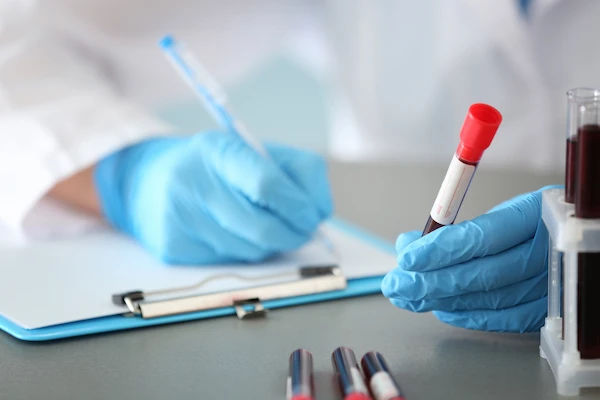Progesterone Test: When to Take It and What It Tells You
Wondering if you’re ovulating? A progesterone test helps confirm ovulation and fertility health. Learn when to take it, what results mean, and how it supports your pregnancy journey.

Written by
Last updated on 17th Jul, 2025

For many women, understanding their menstrual cycle and its intricate hormonal dance is crucial, particularly when trying to conceive or investigating reproductive health concerns. Among the key players in this hormonal symphony is progesterone, a hormone often referred to as the "pregnancy hormone." A progesterone test, specifically when timed correctly, can provide invaluable insights into your ovulation status and overall fertility.
What Progesterone Indicates About Ovulation
Progesterone is primarily produced by the corpus luteum, a temporary gland that forms in the ovary after an egg is released during ovulation. Its main role is to prepare the uterus for a potential pregnancy by thickening the uterine lining (endometrium), making it receptive to a fertilised egg. If pregnancy occurs, progesterone levels continue to rise, supporting the early stages of gestation and maintaining the uterine lining. If pregnancy does not occur, progesterone levels drop, leading to the shedding of the uterine lining, your menstrual period.
Therefore, measuring your progesterone levels can effectively confirm whether ovulation has occurred. A significant rise in progesterone following a suspected ovulation indicates that an egg was indeed released from the ovary, and the corpus luteum is producing this vital hormone. Conversely, persistently low progesterone levels in the mid-luteal phase suggest that ovulation may not have taken place, or that the corpus luteum is not functioning optimally.
The progesterone test is a simple blood test that measures the concentration of progesterone in your bloodstream. It is a non-invasive and highly informative diagnostic tool for anyone tracking ovulation, especially those trying to conceive.
Get Your Reproductive Health Assessed
Ideal Testing Time During Luteal Phase
Accurate interpretation of a progesterone test relies heavily on precise timing. To confirm ovulation, the test must be performed during the mid-luteal phase. This is the period, approximately 7 days after ovulation has occurred, when progesterone levels are expected to be at their peak.
For women with a regular 28-day menstrual cycle, ovulation typically occurs around day 14. Therefore, the ideal time for a progesterone test would be around day 21 of your cycle. This allows sufficient time for the corpus luteum to form and begin producing a substantial amount of progesterone.
However, menstrual cycles vary widely among women. Relying solely on a fixed cycle day might lead to inaccurate results if your ovulation timing differs. This is where understanding your unique ovulation pattern becomes crucial. You can identify your ovulation day through various methods:
- Ovulation Predictor Kits (OPKs): These kits detect the surge in Luteinising Hormone (LH), which typically precedes ovulation by 24-36 hours. Once you detect your LH surge, you can count approximately 7 days from that point for your progesterone test.
- Basal Body Temperature (BBT) Charting: BBT charting involves tracking your body temperature every morning before getting out of bed. A sustained rise in BBT usually indicates that ovulation has occurred. You can then schedule your progesterone test 5-7 days after this sustained temperature shift.
- Ovulation Tracking Apps: Many apps can help you predict your fertile window based on cycle length and other symptoms. While helpful, it's often best to combine app predictions with other methods for greater accuracy.
It is important to communicate with your doctor or healthcare provider about your cycle length and ovulation tracking methods. They can provide personalised guidance on the most appropriate timing for your progesterone test to ensure the most meaningful results. Remember, the goal is to capture your peak progesterone level, which indicates a robust ovulation.
How Results Help Confirm Fertility Window
The results of your progesterone test are invaluable for confirming whether ovulation has taken place and, consequently, understanding your fertility window.
Typically, a progesterone level above a certain threshold in the mid-luteal phase confirms ovulation. While specific normal ranges can vary slightly between laboratories, a level generally above 10 ng/mL (nanograms per millilitre) is considered indicative of healthy ovulation and adequate luteal phase function. Some laboratories might consider a threshold of 5 ng/mL or higher to confirm ovulation, but a higher value indicates stronger ovulation and a healthier luteal phase.
Here's a general interpretation of progesterone levels in the mid-luteal phase:
- High Progesterone Levels (e.g., above 10 ng/mL or 20 ng/mL for some labs): This is excellent news! It strongly suggests that ovulation has occurred, and your body is producing sufficient progesterone to support a potential pregnancy. This confirms that your fertility window was indeed active during that cycle.
- Moderate Progesterone Levels (e.g., 5-10 ng/mL): This indicates that ovulation likely occurred, but the progesterone production might not be optimal. This could suggest a "weak" ovulation or a luteal phase defect, where the corpus luteum isn't producing enough progesterone to adequately prepare the uterus.
- Low Progesterone Levels (e.g., below 5 ng/mL): This typically indicates that ovulation did not occur during that cycle (anovulation). It can also point towards a significant luteal phase deficiency.
Understanding these results helps you and your healthcare provider assess your ovulatory function.
When Low Progesterone Needs Support
While a healthy rise in progesterone is a positive sign, low progesterone levels can be a source of concern for women trying to conceive or experiencing menstrual irregularities. Low progesterone can manifest in various ways, including:
- Irregular or absent periods: Inadequate progesterone can disrupt the regular shedding of the uterine lining, leading to unpredictable cycles or amenorrhea.
- Spotting between periods: This can be a sign of insufficient progesterone support for the uterine lining.
- Difficulty conceiving: If ovulation isn't occurring or the luteal phase is inadequate, it becomes challenging for a fertilised egg to implant and for an early pregnancy to be sustained.
- Recurrent miscarriages: In some cases, low progesterone in early pregnancy can contribute to miscarriage, as the hormone is vital for maintaining the uterine lining and supporting the developing foetus.
- Symptoms of Oestrogen Dominance: When progesterone levels are low relative to oestrogen, symptoms like breast tenderness, mood swings, weight gain, and bloating can occur.
If your progesterone test reveals consistently low levels, your healthcare provider may recommend various strategies to support your progesterone production or supplement it. It is crucial to remember that any intervention for low progesterone should be discussed and managed by a qualified healthcare professional. Self-medicating with hormones can be dangerous and lead to further imbalances. Your doctor will assess your individual situation, determine the underlying cause of low progesterone, and recommend the most appropriate course of action.
Book Ovulation Test Panel With Apollo 24|7
Understanding your ovulatory health is a significant step towards managing your reproductive journey. Apollo 24|7 offers convenient and reliable diagnostic services, including the individual Progesterone Test and other relevant fertility panels.
The Progesterone Test (P4) is a fundamental test for confirming ovulation. While not explicitly named an "Ovulation Test Panel" on the Apollo 24|7 landing page, several tests are crucial for a comprehensive assessment of ovulation and fertility. These often include a combination of hormone tests that collectively paint a clearer picture of your reproductive health. Consider exploring these related tests and packages on Apollo 24|7 that complement a progesterone test for a more complete ovulation assessment:
- Luteinising Hormone (LH) Test: The LH surge is the trigger for ovulation. Testing LH levels helps identify your fertile window before ovulation occurs.
- Follicle-Stimulating Hormone (FSH) Test: FSH is involved in stimulating the growth of ovarian follicles. Along with LH and oestrogen, it provides insights into ovarian function.
- Estradiol (E2) Test: Estradiol, a type of oestrogen, rises before ovulation and influences the uterine lining.
When considering a comprehensive look at your reproductive health, discussing with your doctor which combination of tests would be most beneficial for your specific needs is always recommended. Apollo 24|7 offers various "Reproductive Fertility" packages that may include several of these tests, providing a holistic view.
Advantages of booking with Apollo 24|7:
- Convenience
- Home Sample Collection
- Timely Reports
- NABL Certified Labs
- Experienced Phlebotomists
- Transparent Pricing
- Accessible Healthcare
These advantages collectively make Apollo 24|7 a reliable choice for your diagnostic needs, empowering you with accurate information to make informed health decisions.
Conclusion
A progesterone test is a helpful tool for women who want to better understand their ovulation and improve their chances of getting pregnant. When done at the right time, usually in the middle of the second half of your cycle (the mid-luteal phase), this test can show if you’ve ovulated, how healthy that phase is, and whether your hormone levels are in balance. Knowing this can help you and your doctor make smart decisions about your fertility journey, whether you're trying naturally or thinking about treatment options.
Get Your Reproductive Health Assessed
₹730(₹1825)60% off



